Jigen-Ryu Swordsmanship, by a New York City-based Japanese Kenjutsu Master, 1903. PART 2.
“As a method of physical training, an indispensable part of the culture of the civilized, [the art of swordplay] may still be regarded as an important and, perhaps, one of the most highly developed arts…”
Continued from PART I.
On September 10, 1901, the following announcement appeared in Japan and America, a magazine based at 203 Broadway, New York City:
The famous Japanese fencer, Tatewaki K. Kawasaki, of the “Jigen-ryu” school, who was studying in A. M. Chesbrough Seminary, North Chili, has returned to this city [New York]. He is writing a series of articles in English on his singular sword play, with the view to disclose it to Western fencers and athletes, as well as to the American public.
Tatewaki Kawasaki was one of the first, if not the first, master of Japanese sword technique to write extensively about his art for an American audience. The first of Kawasaki’s articles appeared in the January 25, 1903 issue of the New York Press, and has already been covered here.
Kawasaki’s second article on swordsmanship was published in the August, 1903, issue of Bernarr McFadden’s journal, Physical Culture. Whereas Kawasaki’s first article treated more about the history and culture of the Japanese sword, his second focuses more on its technique.
Following is Kawasaki’s second article for Physical Culture.
“The Noble Soul dwells in the strong body,” is a time-honored maxim of the Japanese; and it was by conforming with this precept that the great Samurai, the trained military men of Old Japan, were enabled to hold, from generation to generation, their rank, dignity and power. The time was when Kenjutsu, the art of swordsmanship of the Japanese, was the exclusive and almost the sole vocation of the knights. But now the age of their pride is past; no longer are they seen strolling the streets of Tokyo with their keen-edged, two-handed blades at their sides, for the enlightenment of Mikado’s reign, which was accomplished by the adaption of the Western civilization, has abolished the feudal system and prohibited the carrying of the sword. With this the art of swordplay has also ceased— ceased to be the sole occupation of the Samurai, or as the means of practical warfare, which is required only in a less civilized country; but, as a method of physical training, an indispensable part of the culture of the civilized, it may still be regarded as an important and, perhaps, one of the most highly developed arts.
I shall bring in here a few points in the Japanese fencing which are particularly fitted for physical development; but before entering into the details, it seems to me proper to give a general view in which are seen the superior aspects of Kenjutsu over the Western fencing as a means of physical culture. The former as a rule requires more general movement and more vigorous exercise of the body than the latter. But the most important and, therefore, the chief point that I wish here to emphasize particularly is the fact that the two-handed play of the Japanese gives an equal chance for the development of both arms; whereas the Western system, in which the single handed sword is alone employed, tends to develop abnormally the muscle of the right arm. The first requisite in the Japanese fencing is to stand as naturally as possible, as this gives the greatest freedom of movement to every part of the body. Different, as they are, when both are compared, in the bearing of the body, or attitude, the Japanese fencer squarely faces his opponent, while the Western fencer shows his side. The obvious result of the comparison of these two positions is that the one keeps constantly the normal posture, which saves him from a tendency to deformity, and the other risks this by an unnatural posture to which the combatant resorts, in order to limit his exposure.
Figure 1 shows a contest initiated by the attitudes of Jodan (right) and Seigan (left), or the attitudes of “upper swing ” and of “straight sight,” respectively. It is readily seen by one who has a little knowledge of fencing that these attitudes are just such as to give the most effective defense. Especially is this true in the attitude of Seigan (left). When an expert fencer assumes this attitude it is almost impossible to find an opening, even by an equally skilled one; and it is here that strategy is required, which may lead one into a trap, -—he is invited by a pretended opening, or else is led to assume some other and less effective position. Yet we can see in this how naturally he stands; there is apparently no strain in his feet or arms.
In Figure 2 the attack has begun. The man who assumed the Seigan position has either been less skilled than the other, or been deceived by strategy; for he receives a blow on the wrist, which is delivered by his opponent with a quick swing of the sword. In this operation the assailant had only to turn his body by reversing the position of his feet.
The Japanese swordsman is not always two-handed. Nor is his swordplay confined to the right arm alone. Left or right, or both, are constantly engaging, as necessity may require or opportunity suggest. It is with almost the skill of a juggler that he does this; for even during the climax of a contest the exchanging of the hold is accomplished as easily as a trick. It will be readily seen that this skill is of great importance from another point of view also. Suppose that the combat here illustrated were a genuine duel. The blow given at the wrist (Figure 2) would have permanently, or at least temporarily, disabled one, and would probably have ended in favor of the other. But here the one quickly turns his sword over to his left hand, and at the same instant thrusts at his rivals throat (Figure 3). The thrust thus given, however, fails by a narrow chance; for his opponent avoids it by simply turning slightly backward. Japanese fencers do not pass the hottest moments of their contest in jumping forward or backward; but the more critical their situation becomes, the cooler is their frame of mind, and the more firmly do they stand.
To beginners of Kenjutsu the most important instruction given is this: The body should be held perfectly upright, the head erect, and the chest raised. The position is well adapted for physical development. The timid bearing, the uncertain stand, and, above all, that instinctive tendency which makes one unconsciously stoop or shrink at an impending danger must be strongly guarded against. Beginners often fail to resist the involuntary closing of the eyes and the lowering of the head at the swing of the opponent’s sword, unmindful, perhaps, that these prevent his seeing the direction of a blow and place his head in more easy reach of the opponent’s sword. Figure 4 illustrates this fault. The blow, which might have been averted, had the victim’s head been erect by turning his body slightly backward, is here fully received. Beginners have to learn to correct the fault by somewhat painful experiences, especially if their instructor be a little careless man.
I cannot here enter into the details bearing on scientific principles that ‘govern’ the Japanese swordplay, which I believe can be better discussed in the light of the mechanical and geometrical theories. The movements are just such as to illustrate well the principle of following the shortest distance, that is to say, of effecting a result by the expenditure of the least possible force.
The readers are now, I believe, ready to see the conclusion that Kenjutsu is well adapted for physical training. And to that I wish to add that it is not only the combination of pleasure and exercise, but it is also an art most manly, and, therefore, worthy of the attention of a most cultured race, the American.

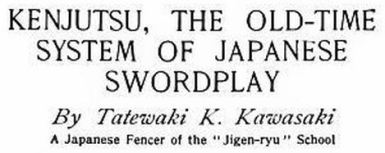
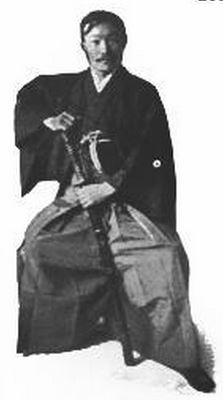
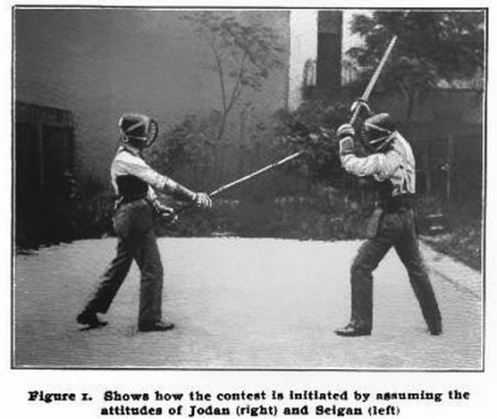
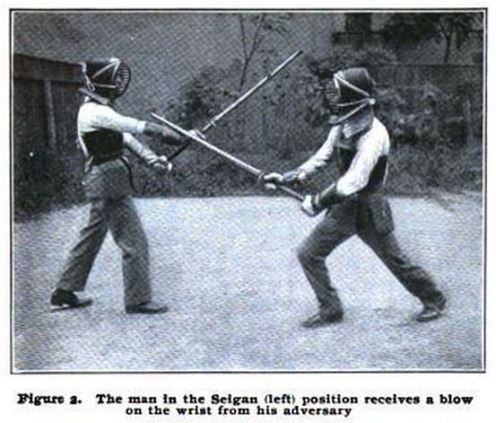
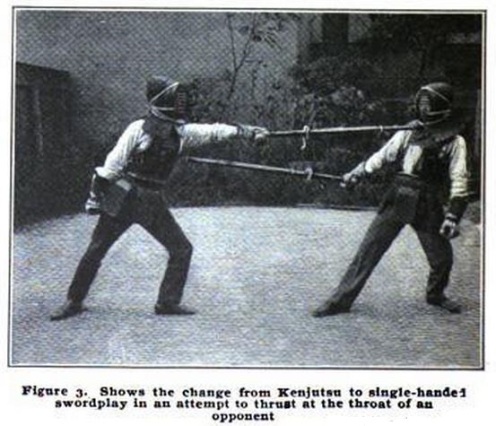
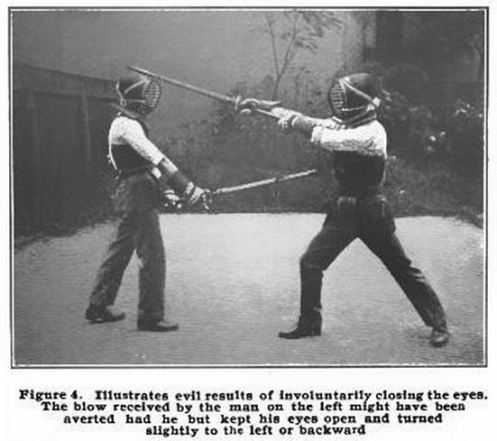
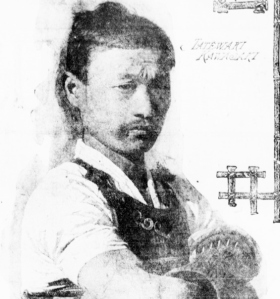

Reblogged this on THE MARTIALXCHANGE.
LikeLike